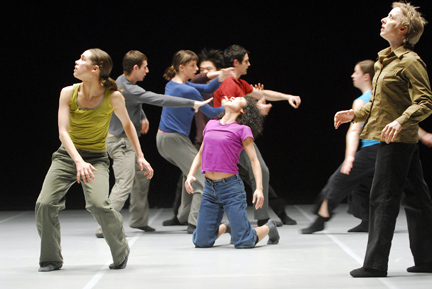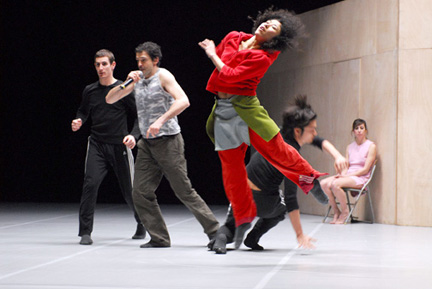Forsythe's "Three Atmospheric Studies"
“Three Atmospheric Studies”
The Forsythe Company
Brooklyn Academy of Music
Brooklyn, NY
March 1, 2007
copyright ©2007, Susan Reiter
 The way words are employed and manipulated to demean and even erase the truth as at the heart of William Forsythe’s “Three Atmospheric Studies,” a deeply personal, unsettling (and not always ideally focused) work that is fully engaged with events taking place in, and shaping our world, at this very moment. Forsythe’s hyper-intellectual approach at times puts the audience at a distance, but at its core grips us from its opening moment by placing us in the midst of tragedy: a mother’s loss of her son amidst the horrors and disorientation of war.
The way words are employed and manipulated to demean and even erase the truth as at the heart of William Forsythe’s “Three Atmospheric Studies,” a deeply personal, unsettling (and not always ideally focused) work that is fully engaged with events taking place in, and shaping our world, at this very moment. Forsythe’s hyper-intellectual approach at times puts the audience at a distance, but at its core grips us from its opening moment by placing us in the midst of tragedy: a mother’s loss of her son amidst the horrors and disorientation of war.
There is no mention of choreography in the credits, which indicate the work was “directed by” Forsythe — and much of it veers more towards theater than dance, with a substantial reliance on text and the way words can be distorted, manipulated and misappropriated. But the opening section is a fierce, uneasy frenzy of movement. After a vulnerable-looking woman (Jone San Martin) wearing a short pink dress comes forward to inform us “This is Composition One, in which my son was arrested” — and points to a nearby man in a red shirt frozen in place — twelve dancers in casual and brightly-colored tops and pants charge through fierce encounters that suggest abortive assaults. Their confrontations seethe with aggression, but they keep arriving in combative arrangements — some paired up as though in combat — but freezing in place and then re-launching into motion.
The expansive stage has a clinical look, with its white floor and four ominous suspended rectangular lamps, and the tension is heightened by the silence in which they perform, with only their breathing sounds, and occasional thuds to the floor, as accompaniment. The resumption and intensification of activity implies the randomness of hostile encounters, yet at the same time is clearly tightly controlled. We are drawn into the kind of terrain — marked by the potential for danger and harm in unpredictable places and at unexpected intervals — in which a family member could be seized and taken away. The dancers display the same remarkable ensemble power and mutual trust that was evident in Forsythe’s “One Flat Thing, Reproduced, in which they maneuvered their bodies over, under and through rows of metal tables in fiercely dynamic but ultimately coordinated ways. They evoke a sense of implied peril without any histrionics, but through the desperation and urgency with which they move.
The setting was then altered during a brief pause — the white floor removed, curtains drawn to create a closed-in space, without wings, and wires stretched across to segment the space — before Part II began. Here, the primary focus is on a claustrophobic interview or interrogation scene between San Martin and a brusque, business-like man (Amancio Gonzalez) who is there to translate her narration of what happened to her son. They sit at separate long tables. His bureaucratic coldness, in the face of her helplessness and fear, is clear from the start, when he announces “I need to get my papers in order.” He obsession with finding exact word equivalents and focus on meaningless details clearly indicates his ignorance of, even disdain for, her plight — indeed, his remoteness from any truly human considerations. “We are not here to write a biography,” he chides her at one point.
Simultaneously but separately, the lanky, very American David Kern is also on stage, busy lecturing in low tones and gesturing about matters we cannot always discern but which come across as mired in technical details. Initially more in the background, her grows more animated. At times, he makes the gesture of framing his face, or indicates the pathway of the intersecting wires. Eventually, he holds up
 Gradually, San Martin is driven to desperation, or distraction, in the face of implacable skepticism, as her words seem to have no meaning to anyone but herself. As the sound score thrums and pounds, her voice takes on a grotesque, whiny sounds through distortion, and she gestures and moves like an automaton. “I am the woman in composition one” she proclaims, “ but soon after asks “which composition is this?” She may or may not be referring to Kern’s ongoing, impersonal discussion, with occasional illustrations held up, of two contrasting compositions; what he is saying is often understated and not entirely discernible. But the growing unease and tension, the complete lack of any productive communication, is evident. No wonder the eerily-timed siren that sounded from the Brooklyn street outside the theater just as this section drew to a close seemed like it might have been part of the performance.
Gradually, San Martin is driven to desperation, or distraction, in the face of implacable skepticism, as her words seem to have no meaning to anyone but herself. As the sound score thrums and pounds, her voice takes on a grotesque, whiny sounds through distortion, and she gestures and moves like an automaton. “I am the woman in composition one” she proclaims, “ but soon after asks “which composition is this?” She may or may not be referring to Kern’s ongoing, impersonal discussion, with occasional illustrations held up, of two contrasting compositions; what he is saying is often understated and not entirely discernible. But the growing unease and tension, the complete lack of any productive communication, is evident. No wonder the eerily-timed siren that sounded from the Brooklyn street outside the theater just as this section drew to a close seemed like it might have been part of the performance.
After intermission, San Martin had been reduced to a helplessly passive bystander in the concluding 20-minute Part III, sitting upstage by a wall, through whose doors dancers appear in twos and threes, rushing and tumbling, sometimes slamming into the wall. The sound score seems to emanate from their falls and crashes, alongside the tough-looking man (Ander Zabala, who represented the son in Part I) whose breathing into a microphone yields harsh, echoing reverberation sounds. Meanwhile, Kern is still there, dispassionately lecturing and illustrating. At first his focus is one a small framed image built into the wall — difficult to discern, it seems to contain a cloud formation — but later on he turns his attention to reporting on the aftermath of a catastrophe, itemizing the scene of destruction, the items, and body parts discovered amid the rubble.
Amidst the ominous scenario, petite blond Dana Caspersen speaks with a voice incongruously distorted to sound like a good-old-boy bureaucrat, mouthing unfeeling platitudes (“you need to understand that this is not personal”). The effect of this unlikely voice — it takes a moment to realize it is coming out of Caspersen -- and its associations with Bush-administration figures and policies, is jarring and more specific than anything that has come before. Done in by the brutal realities brought on by those who mouth platitudes and wreak havoc from a safe distance, San Martin’s mother is, by the end, a complete blank, manipulated from behind in puppet-like fashion, and the scene surrounding her is dominated by the cacophony of loud, explosive sounds and distorted double-speak.
Although overlaid with intellectual conceits, “Three Atmospheric Studies” clearly has been created out of a vigorously engaged perspective, a need to confront the complete range of sources and implications behind contemporary conflicts and policies. It is a vivid, uneasy 90 minutes, a warning about the need to delve behind received imagery and standardized speeches.
Photos by Stephanie Berger.
Volume 5, No. 10
March 12, 2007
copyright ©2007 by Susan Reiter
www.danceviewtimes.com